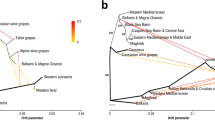
Overview
- Describes the best practices to resolve and annotate grape genomes and transcriptomes
- Provides a uniquely comprehensive description of grapevine genetic diversity and its application in modern breeding programs
- Explains how domestication shaped the grape genome
- Links the grape genome composition and expression to viticulture traits and grape berry quality
Part of the book series: Compendium of Plant Genomes (CPG)
Access this book
Tax calculation will be finalised at checkout
Other ways to access
About this book
Grapes (Vitis vinifera spp. vinifera) have been a source of food and wine since their domestication from their wild progenitor (Vitis vinifera ssp. sylvestris) around 8,000 years ago, and they are now the world’s most valuable horticultural crop. In addition to being economically important, V. vinifera is also a model organism for the study of perennial fruit crops for two reasons: Firstly, its ability to be transformed and micropropagated via somatic embryogenesis, and secondly its relatively small genome size of 500 Mb. The economic importance of grapes made V. vinifera an obvious early candidate for genomic sequencing, and accordingly, two draft genomes were reported in 2007. Remarkably, these were the first genomes of any fruiting crop to be sequenced and only the fourth for flowering plants. Although riddled with gaps and potentially omitting large regions of repetitive sequences, the two genomes have provided valuable insights into grape genomes. Cited in over 2,000 articles, the genome has served as a reference in more than 3,000 genome-wide transcriptional analyses. Further, recent advances in DNA sequencing and bioinformatics are enabling the assembly of reference-grade genome references for more grape genotypes revealing the exceptional extent of structural variation in the species.
Similar content being viewed by others
Keywords
Table of contents (16 chapters)
-
Front Matter
Editors and Affiliations
About the editors
Bibliographic Information
Book Title: The Grape Genome
Editors: Dario Cantu, M. Andrew Walker
Series Title: Compendium of Plant Genomes
DOI: https://doi.org/10.1007/978-3-030-18601-2
Publisher: Springer Cham
eBook Packages: Biomedical and Life Sciences, Biomedical and Life Sciences (R0)
Copyright Information: Springer Nature Switzerland AG 2019
Hardcover ISBN: 978-3-030-18600-5Published: 03 December 2019
Softcover ISBN: 978-3-030-18603-6Published: 21 January 2021
eBook ISBN: 978-3-030-18601-2Published: 13 November 2019
Series ISSN: 2199-4781
Series E-ISSN: 2199-479X
Edition Number: 1
Number of Pages: XXVII, 367
Number of Illustrations: 12 b/w illustrations, 40 illustrations in colour
Topics: Plant Genetics and Genomics, Plant Breeding/Biotechnology, Agriculture



